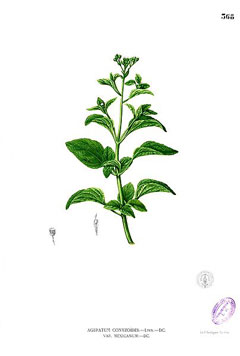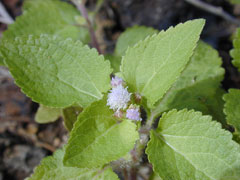 |
|
|
 |
| http://www.hear.org/starr/ |
Translate this page:
Summary
Physical Characteristics

 Ageratum conyzoides is a ANNUAL growing to 1 m (3ft 3in).
Ageratum conyzoides is a ANNUAL growing to 1 m (3ft 3in).
See above for USDA hardiness. It is hardy to UK zone 9. It is in leaf from May to October, in flower from July to September. The species is hermaphrodite (has both male and female organs) and is pollinated by Insects.
Suitable for: light (sandy), medium (loamy) and heavy (clay) soils. Suitable pH: mildly acid, neutral and basic (mildly alkaline) soils. It cannot grow in the shade. It prefers moist soil.
UK Hardiness Map
US Hardiness Map
Synonyms
Plant Habitats
Cultivated Beds;
Edible Uses
References More on Edible Uses
Medicinal Uses
Plants For A Future can not take any responsibility for any adverse effects from the use of plants. Always seek advice from a professional before using a plant medicinally.
Antiinflammatory Leprosy Lithontripic Skin Styptic Vulnerary
The plant contains between 0.7 - 2.0% essential oil, plus alkaloids and saponins[283]. The whole plant is antiinflammatory and antiallergic[283]. The juice of the fresh plant, or an extract of the dried plant, is used in the treatment of allergic rhinitis and sinusitis[283]. The juice of the fresh plant is also useful in treating post-partum uterine haemorrhage[283]. The juice of the root is antilithic[240, 243]. A paste of the root, mixed with the bark of Schinus wallichii, is applied to set dislocated bones[272]. The leaves are styptic[240]. They are dried and applied as a powder to cuts, sores and the ruptures caused by leprosy[272], The powder absorbs the moisture of the disease and forms a layer that is removed after 1 - 2 days[272]. An effective cure for most cuts and sores, though it does not effect a complete cure for leprosy[272]. The leaves are also used externally in the treatment of ague[240, 243]. The juice of the plant is used to treat cuts, wounds and bruises[272]. A paste of the leaves is used as a poultice to remove thorns from the skin[272]. A paste made of the leaves mixed with equal amounts of Bidens pilosa, Drymaria cordata, Galinsoga parviflora and the rhizome of Zingiber officinale is used to treat snakebites[272]. The juice of the flowerheads is used externally to treat scabies, whilst a paste of them is used to treat rheumatism[272]. A tea made from the flowerheads mixed with Ocimum tenuifolium is used to treat coughs and colds[272].
References More on Medicinal Uses
The Bookshop: Edible Plant Books
Our Latest books on Perennial Plants For Food Forests and Permaculture Gardens in paperback or digital formats.

Edible Tropical Plants
Food Forest Plants for Hotter Conditions: 250+ Plants For Tropical Food Forests & Permaculture Gardens.
More

Edible Temperate Plants
Plants for Your Food Forest: 500 Plants for Temperate Food Forests & Permaculture Gardens.
More

More Books
PFAF have eight books available in paperback and digital formats. Browse the shop for more information.
Shop Now
Other Uses
Essential Hair
The leaves and the flowers yield 0.2% essential oil with a powerful nauseating odour[240]. The oil contains 5% eugenol, which has a pleasant odour[240]. The oil from plants growing in Africa has an agreeable odour, consisting almost entirely of eugenol[240]. A decoction of the fresh plant is used as a hair wash, leaving the hair soft, fragrant and dandruff free[283].
Special Uses
Scented Plants
References More on Other Uses
Cultivation details
Succeeds in full sun in a sheltered position in any reasonably fertile moisture-retentive soil that does not dry out in the summer[200]. Plant vigour and flowering periods are much reduced on dry soils[200]. This species is not frost hardy, though it can be grown as a summer annual in Britain[200]. The fresh plant is malodorous[200].
References Carbon Farming Information and Carbon Sequestration Information
Temperature Converter
Type a value in the Celsius field to convert the value to Fahrenheit:
Fahrenheit:
The PFAF Bookshop
Plants For A Future have a number of books available in paperback and digital form. Book titles include Edible Plants, Edible Perennials, Edible Trees,Edible Shrubs, Woodland Gardening, and Temperate Food Forest Plants. Our new book is Food Forest Plants For Hotter Conditions (Tropical and Sub-Tropical).
Shop Now
Plant Propagation
Seed - sow late winter or early spring in a warm greenhouse and only just cover the seed. Prick out the seedlings when large enough to handle and plant out after the last expected frosts[200]. Seed can also be sown in situ in the spring and, for earlier blooms, it is possible to sow it in late summer or early autumn, though it will need to be overwintered in a warm greenhouse[200].
Other Names
If available other names are mentioned here
Native Range
SOUTHERN AMERICA: United States (Puerto Rico), Guatemala, Honduras, Nicaragua, Panama, El Salvador, Venezuela, Brazil, Ecuador, Peru, Argentina, Chile, Paraguay, Uruguay
Weed Potential
Right plant wrong place. We are currently updating this section.
Please note that a plant may be invasive in one area but may not in your area so it's worth checking.
Conservation Status
IUCN Red List of Threatened Plants Status :

Growth: S = slow M = medium F = fast. Soil: L = light (sandy) M = medium H = heavy (clay). pH: A = acid N = neutral B = basic (alkaline). Shade: F = full shade S = semi-shade N = no shade. Moisture: D = dry M = Moist We = wet Wa = water.
Now available:
Food Forest Plants for Mediterranean Conditions
350+ Perennial Plants For Mediterranean and Drier Food Forests and Permaculture Gardens.
[Paperback and eBook]
This is the third in Plants For A Future's series of plant guides for food forests tailored to
specific climate zones. Following volumes on temperate and tropical ecosystems, this book focuses
on species suited to Mediterranean conditions—regions with hot, dry summers and cool, wet winters,
often facing the added challenge of climate change.
Read More
Expert comment
Author
L.
Botanical References
200
Links / References
For a list of references used on this page please go here
Readers comment
| Add a comment |
|
If you have important information about this plant that may help other users please add a comment or link below. Only comments or links that are felt to be directly relevant to a plant will be included. If you think a comment/link or information contained on this page is inaccurate or misleading we would welcome your feedback at [email protected]. If you have questions about a plant please use the Forum on this website as we do not have the resources to answer questions ourselves.
* Please note: the comments by website users are not necessarily those held by PFAF and may give misleading or inaccurate information.
To leave a comment please Register or login here All comments need to be approved so will not appear immediately.
|
Subject : Ageratum conyzoides
|
|
|
|